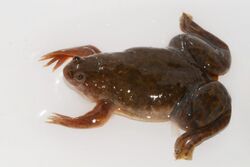Biology:Pipimorpha
| Pipimorpha | |
|---|---|

| |
| Specimen of Xenopus borealis (Pipidae) | |

| |
| Specimen of Palaeobatrachus grandipes (Palaeobatrachidae) | |
| Scientific classification | |
| Domain: | Eukaryota |
| Kingdom: | Animalia |
| Phylum: | Chordata |
| Class: | Amphibia |
| Order: | Anura |
| Clade: | Pipoidea |
| Clade: | Pipimorpha Ford and Cannatella, 1993[1] |
| Subdivisions | |
|
See text | |
Pipimorpha is an unranked clade containing all frogs which are more closely related to living Pipidae species than to living Rhinophrynus species.[2][3] Members of this group are highly adapted to aquatic life. The oldest pipimorphs are Neusibatrachus and Gracilibatrachus from the Early Cretaceous of Spain,[4] with other records of the group known from Afro-Arabia and South America like modern Pipidae.[5] The extinct family Palaeobatrachidae, particularly the genus Palaeobatrachus were widespread and abundant in Europe during the Cenozoic, until their extinction during the Middle Pleistocene around 500,000 years ago due to being unable to cope with the increasing aridity and freezing temperatures of the ice ages.[6]
Taxonomy
Genera are monotypic unless otherwise noted
Taxonomy after A. M. Aranciaga Rolando et al. 2019[5]
- †Neusibatrachus Seiffert 1972 La Pedrera de Rúbies Formation, Spain, Early Cretaceous (Barremian)
- †Gracilibatrachus Baez 2013 Las Hoyas, Spain, Early Cretaceous (Barremian)
- †Nevobatrachus Mahony, 2019 (=Cordicephalus Nevo, 1968) Hatira Formation, Israel, Lower Cretaceous
- †Thoraciliacus Nevo 1968 Hatira Formation, Israel, Lower Cretaceous
- †Avitabatrachus Báez, Trueb & Calvo, 2000 Candeleros Formation, Late Cretaceous (Cenomanian)
- †Vulcanobatrachus Trueb et al. 2005 South Africa, Late Cretaceous
- †Cratopipa Carvalho et al., 2019 Crato Formation, Brazil, Early Cretaceous (Aptian)[7]
- †Palaeobatrachidae Europe, Late Cretaceous-Middle Pleistocene
- †Palaeobatrachus Tschudi, 1838 (13+ species) Europe, Middle Eocene-Middle Pleistocene
- †Albionbatrachus Meszoely, Špinar et Ford, 1984 (2 species) Europe, Eocene-Miocene
- Clade Panpipidae Aranciaga Rolando et al. 2019
- †Clade Shelaniinae Aranciaga Rolando et al. 2019
- †Patagopipa Aranciaga Rolando et al. 2019 Huitrera Formation, Argentina, Eocene
- †Kuruleufenia Gómez 2016 Allen Formation, Argentina, Late Cretaceous (Campanian-Maastrichtian)
- †Saltenia Reig 1959 Las Curtiembres Formation, Argentina, Late Cretaceous (Campanian)
- †Shelania Casamiquela 1960 Laguna del Hunco Formation, Argentina, Eocene
- Pipidae Gray 1825 Africa, South America, Late Cretaceous (Cenomanian) - Present
- †Clade Shelaniinae Aranciaga Rolando et al. 2019
References
- ↑ "The Paleobiology Database". http://paleobackup.nceas.ucsb.edu:8090/cgi-bin/bridge.pl?action=checkTaxonInfo&taxon_no=68503.
- ↑ Cannatella, David (11 January 2008). "Anua: Discussion of Phylogenetic Relationships (Pipimorpha)". Tree of Life Project. http://tolweb.org/Anura/16963#DiscussionofPhylogeneticRelationships. Retrieved 2009-09-28.
- ↑ Trueb, Linda; Ana María Báez (March 2006). "Revision of the Early Cretaceous Cordicephalus from Israel and an assessment of its relationships among pipoid frogs". Journal of Vertebrate Paleontology (The Society of Vertebrate Paleontology) 26 (1): 44–59. doi:10.1671/0272-4634(2006)26[44:ROTECC2.0.CO;2]. http://www.amphibiatree.org/sites/amphibiatree.org/files/TruebBaez2006_Cordicephalus.pdf.
- ↑ Gómez, Raúl O.; Lires, Andres I. (October 2019). "High ecomorphological diversity among Early Cretaceous frogs from a large subtropical wetland of Iberia" (in en). Comptes Rendus Palevol 18 (7): 711–723. doi:10.1016/j.crpv.2019.07.005.
- ↑ 5.0 5.1 Rolando, Alexis M. Aranciaga; Agnolin, Federico L.; Corsolini, Julián (October 2019). "A new pipoid frog (Anura, Pipimorpha) from the Paleogene of Patagonia. Paleobiogeographical implications" (in en). Comptes Rendus Palevol 18 (7): 725–734. doi:10.1016/j.crpv.2019.04.003.
- ↑ Wuttke, Michael; Přikryl, Tomáš; Ratnikov, Viacheslav Yu.; Dvořák, Zdeněk; Roček, Zbyněk (September 2012). "Generic diversity and distributional dynamics of the Palaeobatrachidae (Amphibia: Anura)" (in en). Palaeobiodiversity and Palaeoenvironments 92 (3): 367–395. doi:10.1007/s12549-012-0071-y. ISSN 1867-1594. http://link.springer.com/10.1007/s12549-012-0071-y.
- ↑ Báez, Ana M.; Muzzopappa, Paula; Moura, Geraldo J. Barbosa de (May 2021). "The earliest records of pipimorph frogs from South America (Aptian, Crato Formaton, Brazil): A critical evaluation" (in en). Cretaceous Research 121: 104728. doi:10.1016/j.cretres.2020.104728. https://linkinghub.elsevier.com/retrieve/pii/S0195667120304158.
Wikidata ☰ Q16988140 entry

